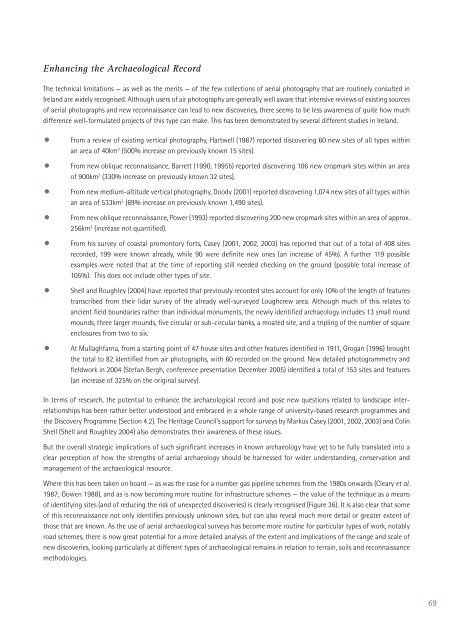Aerial Archaeology in Ireland - The Heritage Council
Aerial Archaeology in Ireland - The Heritage Council
Aerial Archaeology in Ireland - The Heritage Council
You also want an ePaper? Increase the reach of your titles
YUMPU automatically turns print PDFs into web optimized ePapers that Google loves.
Enhanc<strong>in</strong>g the Archaeological Record<br />
<strong>The</strong> technical limitations — as well as the merits — of the few collections of aerial photography that are rout<strong>in</strong>ely consulted <strong>in</strong><br />
<strong>Ireland</strong> are widely recognised. Although users of air photography are generally well aware that <strong>in</strong>tensive reviews of exist<strong>in</strong>g sources<br />
of aerial photographs and new reconnaissance can lead to new discoveries, there seems to be less awareness of quite how much<br />
difference well-formulated projects of this type can make. This has been demonstrated by several different studies <strong>in</strong> <strong>Ireland</strong>.<br />
• From a review of exist<strong>in</strong>g vertical photography, Hartwell (1987) reported discover<strong>in</strong>g 60 new sites of all types with<strong>in</strong><br />
an area of 40km 2 (500% <strong>in</strong>crease on previously known 15 sites).<br />
• From new oblique reconnaissance, Barrett (1990, 1995b) reported discover<strong>in</strong>g 106 new cropmark sites with<strong>in</strong> an area<br />
of 900km 2 (330% <strong>in</strong>crease on previously known 32 sites).<br />
• From new medium-altitude vertical photography, Doody (2001) reported discover<strong>in</strong>g 1,074 new sites of all types with<strong>in</strong><br />
an area of 533km 2 (69% <strong>in</strong>crease on previously known 1,490 sites).<br />
• From new oblique reconnaissance, Power (1993) reported discover<strong>in</strong>g 200 new cropmark sites with<strong>in</strong> an area of approx.<br />
256km 2 (<strong>in</strong>crease not quantified).<br />
• From his survey of coastal promontory forts, Casey (2001, 2002, 2003) has reported that out of a total of 408 sites<br />
recorded, 199 were known already, while 90 were def<strong>in</strong>ite new ones (an <strong>in</strong>crease of 45%). A further 119 possible<br />
examples were noted that at the time of report<strong>in</strong>g still needed check<strong>in</strong>g on the ground (possible total <strong>in</strong>crease of<br />
105%). This does not <strong>in</strong>clude other types of site.<br />
• Shell and Roughley (2004) have reported that previously recorded sites account for only 10% of the length of features<br />
transcribed from their lidar survey of the already well-surveyed Loughcrew area. Although much of this relates to<br />
ancient field boundaries rather than <strong>in</strong>dividual monuments, the newly identified archaeology <strong>in</strong>cludes 13 small round<br />
mounds, three larger mounds, five circular or sub-circular banks, a moated site, and a tripl<strong>in</strong>g of the number of square<br />
enclosures from two to six.<br />
• At Mullaghfarna, from a start<strong>in</strong>g po<strong>in</strong>t of 47 house sites and other features identified <strong>in</strong> 1911, Grogan (1996) brought<br />
the total to 82 identified from air photographs, with 60 recorded on the ground. New detailed photogrammetry and<br />
fieldwork <strong>in</strong> 2004 (Stefan Bergh, conference presentation December 2005) identified a total of 153 sites and features<br />
(an <strong>in</strong>crease of 325% on the orig<strong>in</strong>al survey).<br />
In terms of research, the potential to enhance the archaeological record and pose new questions related to landscape <strong>in</strong>terrelationships<br />
has been rather better understood and embraced <strong>in</strong> a whole range of university-based research programmes and<br />
the Discovery Programme (Section 4.2). <strong>The</strong> <strong>Heritage</strong> <strong>Council</strong>’s support for surveys by Markus Casey (2001, 2002, 2003) and Col<strong>in</strong><br />
Shell (Shell and Roughley 2004) also demonstrates their awareness of these issues.<br />
But the overall strategic implications of such significant <strong>in</strong>creases <strong>in</strong> known archaeology have yet to be fully translated <strong>in</strong>to a<br />
clear perception of how the strengths of aerial archaeology should be harnessed for wider understand<strong>in</strong>g, conservation and<br />
management of the archaeological resource.<br />
Where this has been taken on board — as was the case for a number gas pipel<strong>in</strong>e schemes from the 1980s onwards (Cleary et al.<br />
1987; Gowen 1988), and as is now becom<strong>in</strong>g more rout<strong>in</strong>e for <strong>in</strong>frastructure schemes — the value of the technique as a means<br />
of identify<strong>in</strong>g sites (and of reduc<strong>in</strong>g the risk of unexpected discoveries) is clearly recognised (Figure 36). It is also clear that some<br />
of this reconnaissance not only identifies previously unknown sites, but can also reveal much more detail or greater extent of<br />
those that are known. As the use of aerial archaeological surveys has become more rout<strong>in</strong>e for particular types of work, notably<br />
road schemes, there is now great potential for a more detailed analysis of the extent and implications of the range and scale of<br />
new discoveries, look<strong>in</strong>g particularly at different types of archaeological rema<strong>in</strong>s <strong>in</strong> relation to terra<strong>in</strong>, soils and reconnaissance<br />
methodologies.<br />
69

















